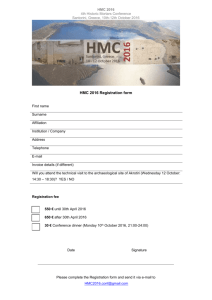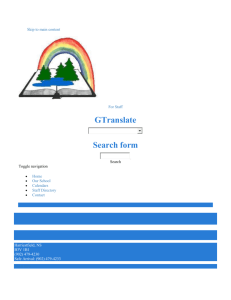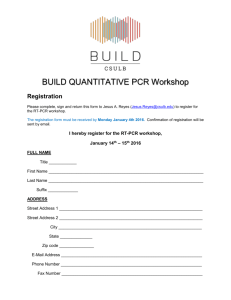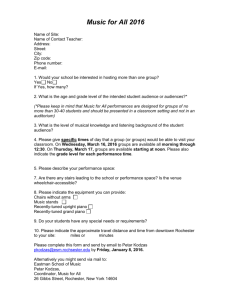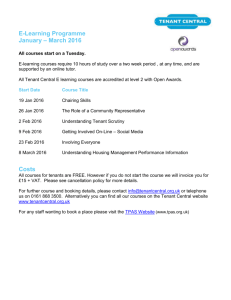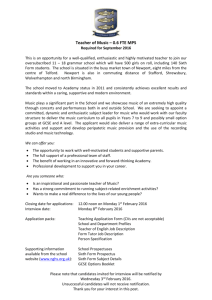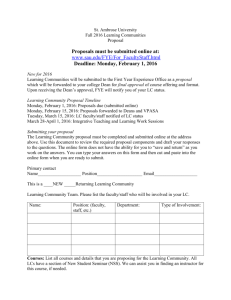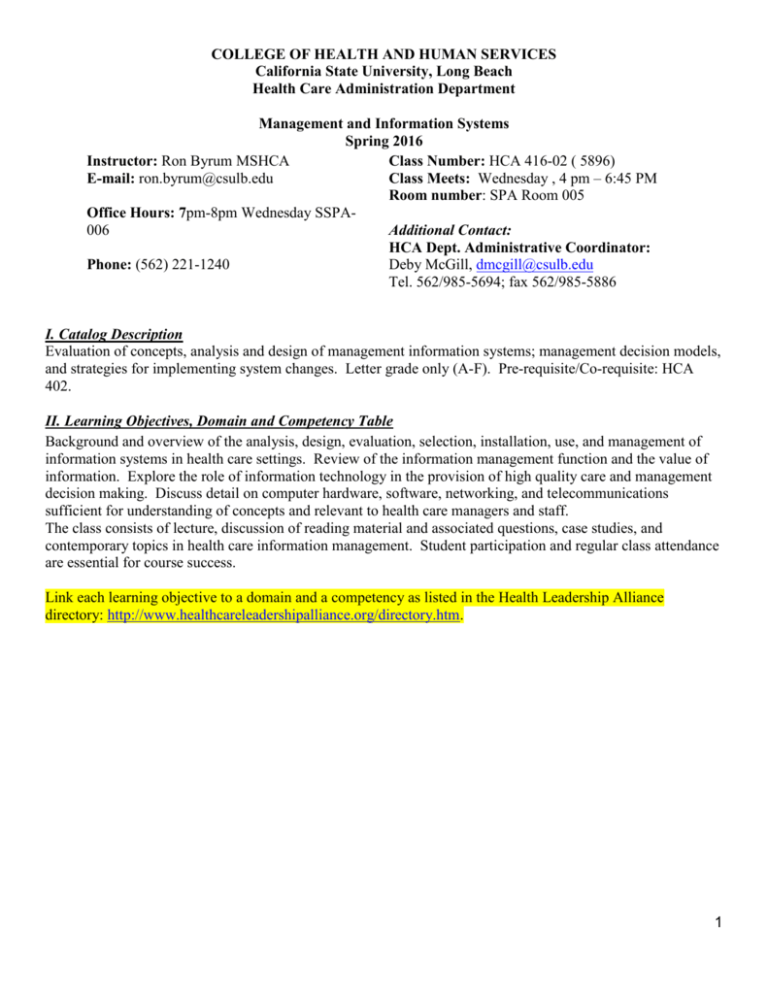
COLLEGE OF HEALTH AND HUMAN SERVICES
California State University, Long Beach
Health Care Administration Department
Management and Information Systems
Spring 2016
Instructor: Ron Byrum MSHCA
Class Number: HCA 416-02 ( 5896)
E-mail: ron.byrum@csulb.edu
Class Meets: Wednesday , 4 pm – 6:45 PM
Room number: SPA Room 005
Office Hours: 7pm-8pm Wednesday SSPA006
Additional Contact:
HCA Dept. Administrative Coordinator:
Phone: (562) 221-1240
Deby McGill, dmcgill@csulb.edu
Tel. 562/985-5694; fax 562/985-5886
I. Catalog Description
Evaluation of concepts, analysis and design of management information systems; management decision models,
and strategies for implementing system changes. Letter grade only (A-F). Pre-requisite/Co-requisite: HCA
402.
II. Learning Objectives, Domain and Competency Table
Background and overview of the analysis, design, evaluation, selection, installation, use, and management of
information systems in health care settings. Review of the information management function and the value of
information. Explore the role of information technology in the provision of high quality care and management
decision making. Discuss detail on computer hardware, software, networking, and telecommunications
sufficient for understanding of concepts and relevant to health care managers and staff.
The class consists of lecture, discussion of reading material and associated questions, case studies, and
contemporary topics in health care information management. Student participation and regular class attendance
are essential for course success.
Link each learning objective to a domain and a competency as listed in the Health Leadership Alliance
directory: http://www.healthcareleadershipalliance.org/directory.htm.
1
Learning Objective- At the
conclusion of this course, the
student will be able to:
Domain
Competency
1. Demonstrate an
understanding of computer
and computer related
terminology.
5
Role and function of information
technology in operations
2. Demonstrate an
understanding of hardware
and software.
5
Information technology (e.g., e-commerce;
Internet; Intranet)
A2, A3
3. Analyze healthcare data using
MS Excel and MS Access.
5
A1, A2, A3
4. Analyze the nature of
information needs in the
organization.
5
Data analysis including manipulation,
understanding of, and ability to explain
data
Role and function of information
technology in operations
5. Demonstrate understanding of
relational database, data
warehouse and data mart
concepts. Understand the
importance of data standards.
5
6. Demonstrate an
understanding of Electronic
Medical Records
5
7. Demonstrate an
understanding of decision
support systems and
processes
5
8. Demonstrate understanding of
basic statistical data used in
healthcare industry
Broad systems connections--potential
impacts and consequences of decisions in a
wide variety of situations both internal and
external
Principles of database and file management
Role of data standards in the health care
environment.
Activity
(A1),
Assignment
(A2) or
Assessment
(A3)
A2, A3
A2, A3
A2, A3
Physician practice management IT systems
(e.g., billing; referral/authorization; claims
processing; electronic medical records;
prescription writing; productivity;
transcription)Role and function of information
technology in operations
A2, A3
5
Role and function of information
technology in operations
A1, A2, A3
9. Demonstrate an
understanding of information
security including HIPAA
regulation.
5
Privacy, confidentiality and security
requirement for information management
(e.g., HIPPAA; Medical Records)
A2, A3
10. Demonstrate an
understanding of creating
reports with Graphs and
charts to present data.
5
Data analysis including manipulation,
understanding of, and ability to explain
data, Turn data into information.
A1, A2, A3
A2, A3
2
III. Text(s) and other course materials
Primary Textbook:
Fenton, Susan H., Biedermann, Sue, Introduction to Healthcare Informatics. American Health Care
Information Management Association, 2014.
Required Reading (Articles and ebook):
Brackett, Michael, Data Resource Data, Technics Publications, (2014), Chapter 3- Data
Responsibility and Data Transformation (Those topics only-ebook, CSULB).
Utley, Craig (2008). Designing the Star Schema Database. CIOBriefings, 1.1. Retrieved from:
http://www.ciobriefings.com/Publications/WhitePapers/DesigningtheStarSchemaDatabase/tabid/101
/Default.aspx
Provost, Lloyd P, Murray, Sandra K, The Health Care Data Guide, Learning from Data for
Improvement, Josey Bass (2011), Chapters 1-2
Austin, Charles J., Boxerman, Stuart B, Information Systems for Health Services Administration
AUHPA Press/Health Administration Press, 6th Edition
Macdonald, Ian Burke, Catherine Stewart, Karl ,Systems Leadership, Creative Positive
Organizations, Part 4, Ashgate Publishing Ltd , 2006 (ebook library),
HIPAA - PHI: List of 18 Identifiers and Definition of PHI. UCSF Human Research Protection
Hsiao, C., Beatty, P., Hing, E., Woodwell, D., Rechtsteiner, E., & Sisk, J. (2009). Electronic Medical
Record/Electronic Health Record Use by Office-based Physicians: United States, 2008 and
Preliminary 2009. Centers for Disease Control and Prevention. Retrieved from:
http://www.cdc.gov/nchs/data/hestat/emr_ehr/emr_ehr.htm
Health Information: Management of a Strategic Resource 4th Edition by Mervat Abdelhak, Ph.D,
RHIA, FAHIMA, Sara Grostick, MA, RHIA, FAHIMA, Mary Alice Hanken, PhD, RHIA,CPRS,
Published by Elsevier Saunders, 2012
IV. Types of Assignments
CLASS DAY.
ALL ASSIGNMENTS WILL BE SUBMITTED BY MIDNIGHT OF
Attendance
2 points per class. Sheet will be provided each class session. It is the responsibility of the
student to sign in with name and CSULB student ID #.
Lab Participation
5 point per lab. 20 points total. Assignments will be posted at the beginning of lab time. Will be
submitted in Drop Box.
Healthcare HIM Interview
20 points. Students will interview someone in the HIM field. Submitted assignment will consist of
summarizing that interview. 250 words. MS Word ( .doc) format. Will be submitted in DropBox
3
In Class Exercise #1
20 points. Students will provide a 250 word Biography on themselves. The biography will contain
the following, Career goals, Post graduation plans, why would you consider a career in HIM, and
what are the career paths in HIM. Will be submitted in Drop Box
Mid Term:
50 points. Open Book/ Open Note. Scan Tron Form 882
Final:
50 Points: Open Book/Open Note. Scan Tron Form 882
Extra Credit
There is no Extra Credit for this class.
Data Project *(Due 4/20)
Project should include the following sections. For more information please refer to Syllabus Review
PowerPoint as well as the project template provided.
Section I: Introduction
Section II: Overall Statistics (includes analysis, tables and graphs)
1. ALOS State Statistic vs. National average
2. Cost per Discharge vs. National average
3. Cost per Day vs. National average
Section III: Top 5 DRGs by Discharges (includes analysis, tables and graphs)
1. Top 5 DRG by Discharge State Statistic
2. Top 5 DRG by Discharge National Statistic
Section IV: Top 5 DRGs by ALOS (includes analysis, tables and graphs)
1. Top 5 DRG by ALOS State Statistic
2. Top 5 DRG by ALOS National Statistic
Section V: Conclusion
Summarize findings and add personal interpretation
What else would you recommend for further research based on your results?
Grading for the term project is broken down by the following categories:
- Data accuracy (30%)
- Data format (15%)
- Graphs (15%)
- Grammar (15%)
- Analysis (15%)
- Structure (10%)
Late Assignments: Any delay in submission will result in 5 percentage points per day up to 8 days.
4
Class Schedule
Class
Date
1
1/20/2016
Topic
Course purpose, outline and
structure
Computer History
Associated Roles in Health
Care Informatics
Reading
Chapter 1-Fenton and Biedermann pages
16-24
Computer History
http://www.computerhistory.org/timel
ine/?category=cmptr
2
1/27/2016
Health Care Information
Infrastructure and Systems
History of EHR
Introduction to the
Electronic Health Record
Chapter 1-Fenton and Biedermann pages
1-16
Chapter 3-Fenton and Biedermann
3
2/03/2016
Chapter 4-Fenton and Biedrmann-pp. 9394
Chapter 5-Fenton and Biedermann
4
2/10/2016
Data Management
Data Marts
Data Transformation
MS Access Lab –
Introduction to Access
Computer Files
Databases
Relational Databases
Data Management
Turn In
In Class Exercise #1
Chapter-4 Fenton and Biedermann
Fundamentals of Relational Database
Design
http://r937.com/relational.html
Access Terminology
Access
teminology.pdf
5
2/17/2016
Data Standards
Understanding
Terminologies
6
2/24/2016
MS Access Lab Exercise
7
3/02/2016
EMR: Electronic Medical
Records
Midterm review
.
Chapter 9-Fenton and Biedermann
Lab Assignment
Chapter 2-Fenton and Biedermann
Electronic Medical Records." Open
Clinic. 4 Nov. 2006
<http://www.openclinical.org/emr.html
http://www.aha.org/advocacyissues/hit/index.shtml
8
03/09/2016
Intro to Excel
Assignment TBD
Lab Assignment
5
Class
Date
9
03/16/2016
Topic
Metrics
“Big Data”
Utilization
Readmission Rates
Quality of Care
Decision Support
Reporting
Reading
Chapter 7-Fenton and Biedermann
Turn In
Mid Term
All Chapter
Wiley_CIO_Volume_
from Weeks
578_Big_Data_Big_Analytics_Emerging_Business_Intelligence_and_Analytic_Trends_for_
What is Care Management?
http://www.rwjf.org/content/dam/farm/r
eports/issue_briefs/2009/rwjf49853
1-8.
Hospital Utilization
(in non-Federal short-stay hospitals)
http://www.cdc.gov/nchs/fastats/hospital.
htm
Calculation of the Office of Statewide
Health Planning and Development’s
(OSHPD) Case Mix Index (CMI)
http://www.oshpd.ca.gov/HID/Products/P
atDischargeData/CaseMixIndex/default.a
sp
Managed Care Resources, Inc
http://www.mcres.com/mcrdef.htm
What criteria should we use when
screening measures of quality for
public reporting?
http://www.ahrq.gov/qual/perfmeasguide/
perfmeaspt4a.htm#q22
Readmission Reduction
http://www.cms.gov/Medicare/MedicareFee-for-ServicePayment/AcuteInpatientPPS/Readmission
s-Reduction-Program.html
10
11
03/23/2016
04/06/2016
MS Excel – Graphs and
pivot table
Graphical Display
MS Excel – formulas and
reporting exercises (5%)
Guest Speaker
LAB exercises: creating graphs and pivot
tables
LAB exercises: calculating key health
care statistics using Excel
HIM
Interview
Due.
Lab Assignment
6
Class
12
Date
04/13/2016
Topic
Business application
Database and Access
Review
Reading
Chapters 1-2, Provost and Murray, The
Health Care Data Guide, (ebook, library)
Turn In
Lab Assignment
An Environmental Snapshot-- Quality
Measurement Enabled by Health IT:
Overview, Challenges, and Possibilities
http://healthit.ahrq.gov/portal/server.pt/co
mmunity/ahrqfunded_projects/654/health_itenabled_quality_measurement/30886
13
04/20/2016
Independent Study-Term
Project is due at 12 MN
14
04/27/2016
15
05/04/2016
System Lifecycle and
project management
The Legal Electronic Health
Record
Final Review
16
TBD per
Campus
Schedule
Security
Privacy
Final
Term
Project due
Midnight
Chapter 10 Fenton and Biedermann
Chapter 11 Fenton and Biedermann
HIPAA - PHI: List of 18 Identifiers and
Definition of PHI." UCSF Human
Research Protection Program. 20 Nov.
2003. 4 Nov. 2006
http://www.research.ucsf.edu/chr/HIPAA/
chrHIPAAphi.asp
Chapter 6-Fenton and Biedermenan
Chapter 12-Fenton and Biedermann
Coordination in Large Agile Projects, Xu,
Peng, Review of Business Information
Systems, Volume 13, No. 4 pp. 29-43.
All
Chapters
7
V. Basis for Assigning the Course Grade
Points possible
30 points
20 points
Details
- Attendance
Lab Projects
100 points
100 points
Data Project
- Mid-term (multiple-choice)—50 questions (25%)
- Final (multiple-choice)—50 questions (25%)
In Class Exercise and HIM Interview
40 points
Final grade calculation= 90% and Greater A, 80 to 89.4 % B, 70 t0 79.4% C, 60-69.4% D, Less than 60% F.
.
VI. Withdrawal policy
Per University Policy.
VII. Attendance policy
Students are expected to attend classes regularly and arrive on time. Students should not miss classes except for
valid reasons such as illness, accident or participation in officially approved University activities. Students are
expected to notify their instructor in advance when they know they will have an excused absence. It is the
student’s responsibility to arrange to make up any work missed. All unexcused absences will result in 1 point
reduction in your attendance grade.
VIII. Students Requiring Accommodations for Special Needs
It is the student’s responsibility to notify the University for Accomodation of Special Needs.
VIIII. Commitment to Inclusion
California State University, Long Beach is committed to maintaining an inclusive learning community that
values diversity and fosters mutual respect. All students have the right to participate fully in university
programs and activities free from discrimination, harassment, sexual violence, and retaliation. Students who
believe they have been subjected to discrimination, harassment, sexual violence, or retaliation on the basis of a
protected status such as age, disability, gender, gender identity/expression, sexual orientation, race, color,
ethnicity, religion, national origin, veteran/veteran status or any other status protected by law, should contact the
Office of Equity and Diversity at (562) 985-8256, University Student Union (USU) Suite 301,
http://www.csulb.edu/depts/oed.
X. Cheating and plagiarism
University policy: http://www.csulb.edu/divisions/aa/grad_undergrad/senate/documents/policy/2008/02.
The following is excerpted from the California State University, Long Beach Policy Statement 85-19,
dated December 13, 1985.
It is the policy of the faculty and administration to deal effectively with the student who practices cheating or
plagiarism. These acts are fundamentally destructive of the process of education and the confident evaluation
of a student's mastery over a subject. A University maintains respect and functions successfully within the
larger community when its reputation is built on honesty. By the same token, each student benefits in helping
to maintain the integrity of the University. This policy, therefore, provides for a variety of faculty actions
including those which may lead to the assignment of a failing grade for a course and for administrative actions
8
which may lead to dismissal from the University. It is the intent to support the traditional values that students
are on their honor to perform their academic duties in an ethical manner.
The following definitions of cheating and plagiarism shall apply to all work submitted by a student.
Plagiarism is defined as the act of using the ideas or work of another person or persons as if they were one's
own, without giving credit to the source. Such an act is not plagiarism if it is ascertained that the ideas were
arrived at through independent reasoning or logic or where the thought or idea is common knowledge.
Acknowledge of an original author or source must be made through appropriate references, i.e., quotation
marks, footnotes, or commentary. Examples of plagiarism include, but are not limited to, the following: the
submission of a work, either in part or in whole, completed by another; failure to give credit for ideas,
statements, facts or conclusions with rightfully belong to another; in written work, failure to use quotation
marks when quoting directly from another, whether it be a paragraph, a sentence, or even a part thereof; close
and lengthy paraphrasing of another writing or paraphrasing should consult the instructor.
Students are cautioned that, in conducting their research, they should prepare their notes by (a) either quoting
material exactly (using quotation marks) at the time they take notes from a source; or (b) departing completely
from the language used in the source, putting the material into their own words. In this way, when the material
is used in the paper or project, the student can avoid plagiarism resulting from verbatim use of notes. Both
quoted and paraphrased materials must be given proper citations.
Cheating is defined as the act of obtaining or attempting to obtain or aiding another to obtain academic credit
for work by the use of any dishonest, deceptive or fraudulent means. Examples of cheating during an
examination would include, but not be limited to the following: copying, either in part or in wholes, from
another test or examination; discussion of answers or ideas relating to the answers on an examination or test
unless such discussion is specifically authorized by the instructor; giving or receiving copies of an exam without
the permission of the instructor; using or displaying notes; "cheat sheets," or other information or devices
inappropriate to the prescribed test conditions, as when the test of competence includes a test of unassisted
recall of information, skill, or procedure; allowing someone other than the officially enrolled student to
represent the same. Also included are plagiarism as defined and altering or interfering with the grading
procedures.
It is often appropriate for students to study together or to work in teams on projects. However, such students
should be careful to avoid use of unauthorized assistance, and to avoid any implication of cheating, by such
means as sitting apart from one another in examinations, presenting the work in a manner which clearly
indicates the effort of each individual, or such other method as is appropriate to the particular course.
One or more of the following academic actions are available to the faculty member who finds a student has
been cheating or plagiarizing.
(a) Review -- no action.
(b) An oral reprimand with emphasis on counseling toward prevention of further occurrences;
(c) A requirement that the work be repeated;
(d) Assignment of a score of zero (0) for the specific demonstration of competence, resulting in
the proportional reduction of final course grade;
(e) Assignment of a failing final grade;
(f) Referral to the Office of Judicial Affairs for possible probation, suspension, or expulsion.
9
XI. Bibliography
American Hospital Association (2010). The Road to Meaningful Use: What it Takes to Implement Electronic
Health Records. TrendWatch April 2010.
Di Donato, J and Walker S. (2008). Health Information Management: What Business Are We In? Health
Information Management Journal.
Hammond, W. Ed (2005), The Making And Adoption Of Health Data Standards, Health Affairs, Volume 24,
Number 5, pp. 1205-1213.
Miller, C. (2007). A Healthier Dose of Data Storage. ADVANCE for Health Information Professionals.
Gartee, R. (2010). Electronic Health Records. Upper Saddle River, NJ: Pearson-Prentice Hall
Marchibroda, J. (2010). There Can Be No Reform Without an Information Revolution. Forbes.com
Pickens S., & Solak J. (2005). National provider identifier (NPI) planning and implementation fundamentals for
providers and payers. Journal of Healthcare Information Management, p. 41-47.
Smaltz D., Callander R., Turner M., Kennamer G., Wurtz H., Bowen A., & Waldrum M.R (2005). Making
sausage—effective management of enterprise-wide clinical IT projects care Journal of Healthcare Information
Management, p. 48-55
Smith, Mark, Saunders, Robert, Stuckhardt, Leigh, McGinnis, J. Michael,Editors; Committee on the Learning
Health Care System in America; Institute of Medicine (Pre Publication Copy) (2012) Best Care at Lower Cost:
The Path to Continuously Learning Health Care in America, pp. 34-41
Zhang, Yang, Fong, Simon, Fiaidhi, Jinan, Mohammed, Sabah, (2012) Real-Time Clinical Decision Support
System with Data Stream Mining, Journal of Biomedicine and Biotechnology, Volume 2012, Article ID
580186, 8 pages.
XII. Additional information resources
For more information on the university syllabus policy please go to the Faculty Center for Professional
Development website at: http://www.csulb.edu/divisions/aa/personnel/fcpd/.
The faculty handbook can also be found online at the following link:
http://www.csulb.edu/divisions/aa/personnel/handbook/
10




